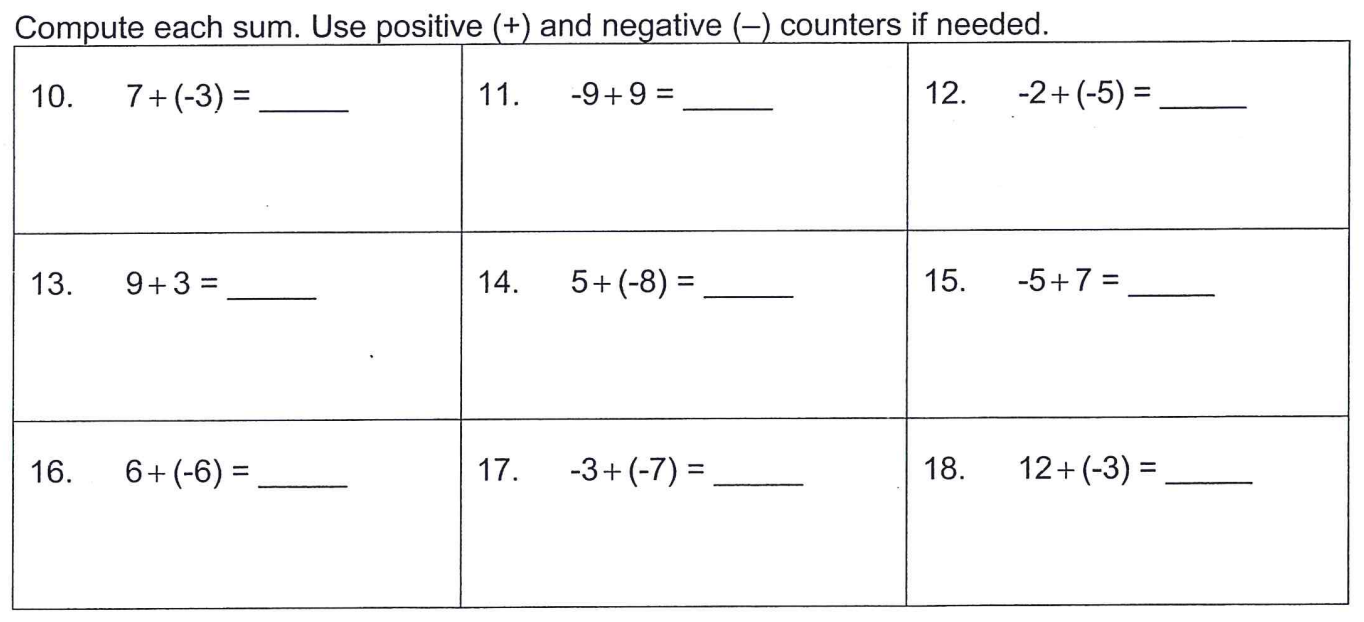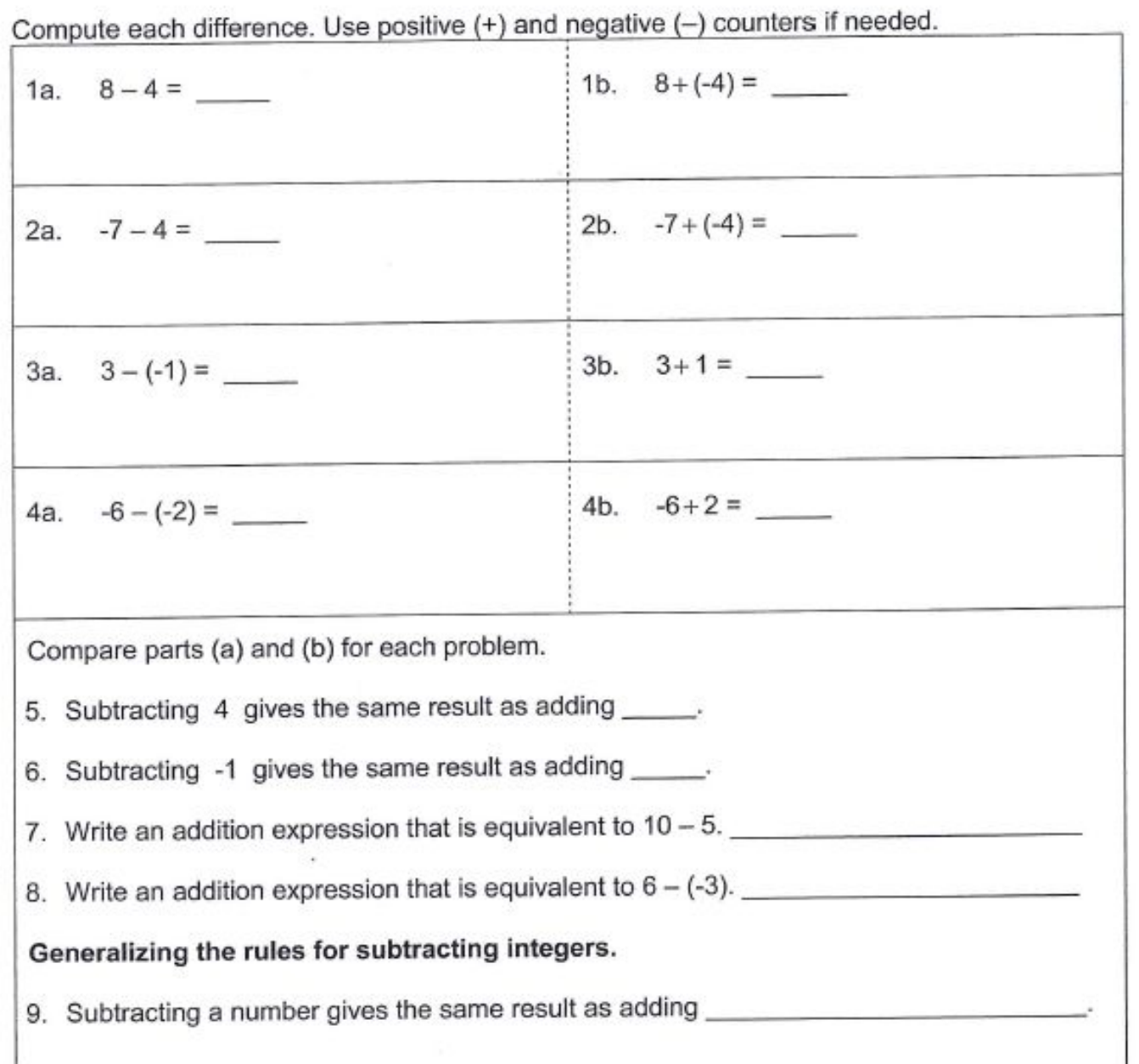Week 9 – Addition of signed numbers
 Does adding a zero pair to a collection change it's value?
Adding Integers 1.1
Does adding a zero pair to a collection change it's value?
Adding Integers 1.1  Assignment: 2.2.1 Homework (Skip 2-37)
Assignment: 2.2.1 Homework (Skip 2-37) Week 9 – Subtraction of signed numbers
In a far-off land, there was once a team of amazing chefs who cooked up the most wonderful soups ever imagined.
They prepared their mixtures over a huge cauldron, and their work was very delicate and complex. During the cooking process, they frequently had to change the temperature of the cauldron in order to bring out certain flavors and cook the soup to perfection.
They adjusted the temperature of the soups either by adding special hot cubes or cold cubes to the cauldron or by removing some of the hot or cold cubes that were already in the cauldron. The cold cubes were similar to ice cubes except they didn’t melt, and the hot cubes were similar to charcoal briquettes, except they didn’t’ lose their heat.
If the number of hot cubes in the cauldron was the same as the number of cold cubes, the temperature of the cauldron was 0° on their temperature scale. For each hot cube that was put into the cauldron, the temperature went up one degree; for each hot cube removed, the temperature went down one degree. Similarly, each cold cube put in lowered the temperature one degree and each cold cube removed raised it one degree.
The chefs used positive and negative numbers to keep track of the changes they were making to the temperature.
For example, suppose 4 hot cubes and 10 cold cubes were dumped into the cauldron. Then the temperature would be lowered by 6° altogether, since 4 of the 10 cold cubes would balance out the 4 hot cubes, leaving 6 cold cubes to lower the temperature 6°, and they would write:
+4 + -10
-6
Similarly, if they added 3 hot cubes and then removed 2 cold cubes, the combined result would be to raise the temperature 5°. In that case they would write:
+3 - -2
+5
Chef's Soup - Student Task
Week 10 – Mixed Integer Addition and Subtraction
2-57. WIN-A-ROW Scoring: When all the boxes in the table have been filled in, calculate the sum of each row and the sum of each column. Every positive sum means one point for Player 1. Every negative sum means one point for Player 2.
How to Play the Game:
Scoring: When all the boxes in the table have been filled in, calculate the sum of each row and the sum of each column. Every positive sum means one point for Player 1. Every negative sum means one point for Player 2.
How to Play the Game:
 Scoring: When all the boxes in the table have been filled in, calculate the sum of each row and the sum of each column. Every positive sum means one point for Player 1. Every negative sum means one point for Player 2.
How to Play the Game:
Scoring: When all the boxes in the table have been filled in, calculate the sum of each row and the sum of each column. Every positive sum means one point for Player 1. Every negative sum means one point for Player 2.
How to Play the Game:
- Play one round of rock-paper-scissors to determine who plays first.
- Player 1 places one of the numbers 1, 2, 3, 4, 5, 6, 7, or 8 in the square he or she chooses and then crosses that number from the list.
- Player 2 places one of the numbers –1, –2, –3, –4, –5, –6, –7, or –8 in another square and then crosses that number from the list.
- Alternate play until all squares are full and all of the numbers have been crossed off the list.
- Add the numbers in each row and write each row’s sum on the appropriate blank in the “Sum” column. Give the winner of each row one point.
- Add the numbers in each column and write each column’s sum on the appropriate blank in the “Sum” row. Give the winner of each column one point.
- If the two players tie after adding the rows and columns, find the sum of the diagonal (from top to bottom and left to right) to decide the final winner.
- If the two players’ sums are still tied, find the sum of the other diagonal (from bottom to top and left to right) to decide the final winner.
- If the game is still tied at this point, both players win!
Week 11 – Integer Multiplication
- What does 2(3 + 5) mean? What is the value of this expression? Describe it with words and counters.
- What does 2(3) + 5 mean? What is the value of this expression? Describe it with words and counters.
- Compare 2(3 + 5) with 2(3) + 5. How are these expressions the same or different? Explain your thinking and draw counters.
For the following expressions, use counters to simplify.
Integer Multiplication 2 - WB
- 3(2) + 3(3) + (−5) + 4
- 5 + 3 + 4(1 + −1) + (−3) + (−5) + 3(5 + (−2)) + 1
Integer Multiplication 2 - WB
Use each integer –6, 2, –3, and 1 once with any of the four operations or parentheses to make:
- The largest possible answer.
- Zero or the closest number to zero.
- The smallest possible answer.
Week 12 – Division and Mixed Integers
Accordion Sample Description
Accordion Sample Description




 Assignment:
Assignment:  Assignment:
Assignment:  Assignment:
Assignment: 
 Printable:
Printable: